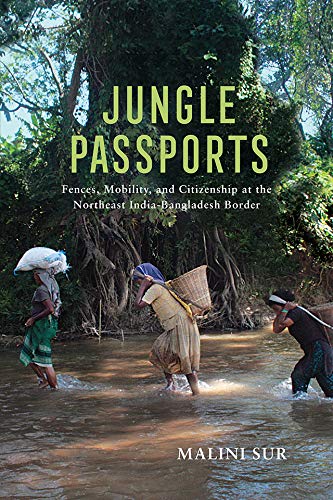Jungle Passports: Fences, Mobility, and Citizenship at the Northeast India-Bangladesh Border

When Malini Sur visited a remote village along the India-Bangladesh border for the first time to conduct fieldwork for her PhD dissertation in 2007, she had no intention of staying in the area or conducting fieldwork until 2015. Or even writing a book. At that time, she intended to study the lives and the journeys of the undocumented Bangladeshi migrants who travelled from the border into various Indian cities.
Malini’s attention however began to shift towards the inhabitants of this borderland when India started to construct a multilayered fence along its border with Bangladesh.
The Bangladesh-India border is 2,545 miles in length, which makes it one of the longest and most militarized border fences in the world. While it is not a hotly contested area, such as the India-Pakistan border, Malini describes it as a site of land and identity conflicts. Since the nineteenth century, a succession of states has classified the inhabitants of Northeast India-Bangladesh as Muslim ‘“frontier peasants”, “savage mountaineers” and Christian “ethnic minorities”, suspecting them of being disloyal subjects, spies, and traitors.
Between 2007 and 2015, Malini lived on both sides of the fence dividing North-East India and Bangladesh and studied the ever-shifting forms of the border. She describes her time there as being greeted with suspicion by all parties. ‘They all thought that I was either sent in to spy on them or recruited by one of the armed dissident groups active in the area. But in the end, villagers didn’t want me to leave’ she says.
Her book, Jungle Passports, is the outcome of extensive ethnographic fieldwork. Malini analyses the impact India’s border construction has on the established notions of mobility and citizenship, and time and histories. Despite the border’s determination to create uniform space and rules, she observed that the rural borderland societies’ resistance to such concepts continued to forge complex alliances and kinship across the fence. Against the backdrop of violence, scarcity, and India’s border construction, she followed the struggles of the undocumented people who took journeys across previously unrecognised borders to secure shifting land, gain access to rice harvests and smuggle the cattle which their livelihoods depend on.
Malini recounts the first time she cycled through the border road with Chandra, a border villager and the disorientation she experienced.
“As Chandra and I cycled along the international boundary, she extended an arm and a leg over the boundary so that her outstretched limbs were in Bangladesh and her body in India…..Pillar 2275 was a concrete triangle with “India” inscribed on one side and “Bangladesh” on the other. On our west was India’s partly constructed new fence.”
In Jungle Passports she also shows how border infrastructures impact far more than human lives. Malini illustrates how elephants trampled upon the newly laid pillars of the fence and destroyed rice harvests and houses, after elephant corridors were disrupted by the construction.
Malini started writing the book the year after completing her fieldwork in 2015 and moving to ICS. ‘I was assigned one of the remotest corner rooms in a historical building in our South Parramatta campus, I wrote the book from here’ she laughs and adds: ‘This book is an outcome of my time at Western Sydney University. ICS’s corridors are vibrant places to have cross-disciplinary dialogues and my anthropology colleagues at the School of Social Sciences grounded me in important disciplinary debates.’
You can order the book now! https://tinyurl.com/yh4neybn




